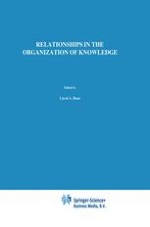2001 | OriginalPaper | Buchkapitel
Relationships in Medical Subject Headings (MeSH)
verfasst von : Stuart J. Nelson, W. Douglas Johnston, Betsy L. Humphreys
Erschienen in: Relationships in the Organization of Knowledge
Verlag: Springer Netherlands
Enthalten in: Professional Book Archive
Aktivieren Sie unsere intelligente Suche, um passende Fachinhalte oder Patente zu finden.
Wählen Sie Textabschnitte aus um mit Künstlicher Intelligenz passenden Patente zu finden. powered by
Markieren Sie Textabschnitte, um KI-gestützt weitere passende Inhalte zu finden. powered by
Recent efforts to make some of the relationships within MeSH more explicit have led to a deeper understanding of the nature of these relationships. This chapter will explore the relationships represented in MeSH in the light of that understanding. Every term that occurs may be thought of as representing a concept. One or more terms, comprising one or more concepts, grouped together for important reasons, form a descriptor class. The descriptor class is the basic building block of the thesaurus. Relationships among concepts can be represented explicitly in the thesaurus, most notably as relationships within the descriptor class. Hierarchical relationships are at the level of the descriptor class. The hierarchies are key in allowing expanded retrievals. The hierarchical relationships, traditionally thought of as broader or narrower (parent-child) relationships, are better understood as representing broader and narrower retrieval sets. Nevertheless, these hierarchical relationships often reflect important broader-narrower relationships between preferred concepts in descriptor classes. Other types of relationships present in the thesaurus include associative relationships, such as the Pharmacologic Actions or see-related cross references, as well as forbidden combination expressions, such as the Entry Combination.
